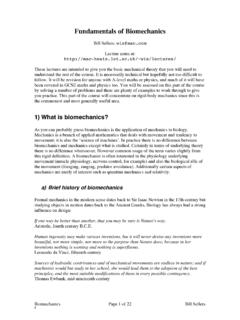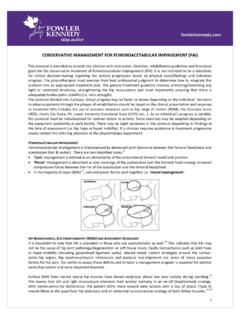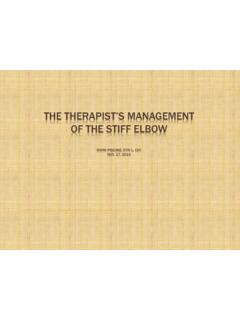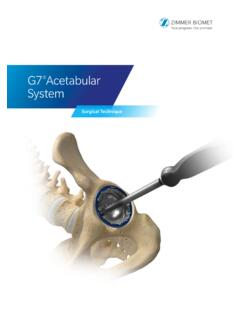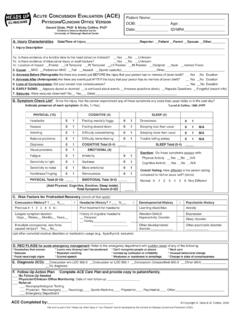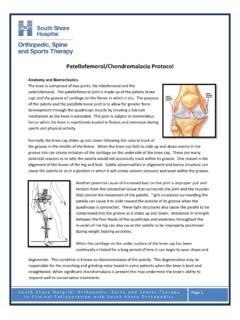Transcription of Biomechanics of Gait and Running
1 JK Loudon, PhD, PT, ATC 1 Biomechanics of Gait and Running I. normal Gait STANCE (60-62% gait cycle) Initial Contact: The moment the foot contacts the ground. Loading Response: Weight is rapidly transferred onto the outstretched limb, the first period of double-limb support. Midstance: The body progresses over a single, stable limb. Terminal Stance: Progression over the stance limb continues. The body moves ahead of the limb and weight is transferred onto the forefoot. Pre-swing: A rapid unloading of the limb occurs as weight is transferred to the contralateral limb, the second period of double-limb support. SWING (38-40% gait cycle) Initial Swing: The thigh begins to advance as the foot comes up off the floor. Mid Swing: The thigh continues to advance as the knee begins to extend, the foot clears the ground. Terminal Swing: The knee extends, the limb prepares to contact the ground.
2 The Functional Phases of the Gait Cycle Stance (62%) Swing (38%) IC LR MS TS PSw ISw MSw TSw Weight Acceptance Single Limb Support Swing Limb Advance II. normal Stride Characteristics A. Cadence: steps / time JK Loudon, PhD, PT, ATC 2 Adult: approx. 2 steps/sec Females (20 - 69 years old): 121 steps/min Males (20 - 69 years old): 111 steps/min B. Velocity: distance/time Adult: m/sec Females (20 - 69 years old): m/min Males (20 - 69 years old): m/min C. Stride length: right heel strike to right heel strike Adult: m Females (20 - 69 years old): .13 m Males (20 - 69 years old): .15 m III. Abnormalities during Weight Acceptance: Joint Deviation: Possible Cause JK Loudon, PhD, PT, ATC 3 Trunk Backward lean: To decrease demand on hip extensors (glut max) Forward lean: Due to increased hip flexion (joint contracture or mm weakness) Lateral Lean: R/L Weak hip abductors Pelvis Contralateral drops: Weak hip abductors on reference limb Ipsilateral drops: Compensation for shortened limb Hip Excessive flexion: Hip flexion contracture, excessive knee flexion Limited flexion: Weakness of hip flexors, decreased hip flexion Knee Excessive flexion: Knee pain, weak quads, short leg on opposite side Hyperextension: Decreased dorsiflexion, weak quads Extension thrust: Intention to increase limb stability Ankle Forefoot contact: Heel pain, excessive knee flexion, pf contracture Foot flat contact: Dorsiflexion contracture, weak dorsiflexors Foot slap: Weak dorsiflexors Toes Up: Compensation for weak anterior tib IV.
3 Abnormalities during Single Limb Support: Joint Deviation: Possible Cause Trunk Backward lean: To decrease demand on hip extensors (glut max) Forward lean: Due to increased hip flexion (joint contracture or mm weakness) Lateral Lean: R/L Weak hip abductors Pelvis Contralateral drops: Weak hip abductors on reference limb Ipsilateral drops: Compensation for shortened limb Anterior Pelvic Tilt: Hip flexion contracture Hip Limited flexion: Weakness of hip flexors, decreased hip flexion Internal Rotation: Weak external rotators, femoral anteversion External Rotation: Retroversion, limited dorsiflexion Abduction: Reference limb longer Adduction: Secondary to contralateral pelvic drop Knee Excessive flexion: Knee pain, weak quads, short leg on opposite side Hyperextension: Decreased dorsiflexion, weak quads Extension thrust: Intention to increase limb stability Wobbles: Impaired proprioception Varus: Joint instability, bony deformity Valgus: Lateral trunk lean, Joint instability, bony deformity Ankle Excessive plantarflexion: Weak quads, Impaired proprioception, ankle pain Early heel off: Tight dorsiflexors, Increased pronation: STJ deformity, Toes Up: Compensation for weak anterior tib JK Loudon, PhD, PT, ATC 4 V.
4 Abnormalities during Swing Limb Advance: Joint Deviation: Possible Cause Trunk Backward lean: To decrease demand on hip extensors (glut max) Forward lean: Due to increased hip flexion (joint contracture or mm weakness) Lateral Lean: R/L Weak hip abductors Pelvis Hikes: Clear swing limb Ipsilateral drops: Weak hip abductors on contralateral side Hip Limited flexion: Weakness of hip flexors, decreased hip flexion, hip pain Knee Limited flexion: Excess hip flexion, knee pain Excess flexion: Knee contracture, weak quads Ankle Excessive plantarflexion: Weak quads, Impaired proprioception, ankle pain Drag: Secondary to limited hip flexion, knee flexion or excess pf Contralateral Vaulting: Compensation for limited flexion of swing or long swing limb Toes Inadequate extension:Limited joint motion, forefoot pain, no heel off Clawed/hammered: Imbalance of long toe extensors and intrinsics, weak pf VI. Running Gait Variations from walking: $ $ $ $ STANCE (30 - 40%) Foot Strike: Mid-support: Take-off (propulsion) SWING (60 - 70%) Follow through: Forward swing: Foot descent: JK Loudon, PhD, PT, ATC 5 VII.
5 Running Faults: JK Loudon, PhD, PT, ATC 6 Subject Questionnaire Name_____ Date_____ Age_____ Height_____ Weight_____ Medical History Relative to the last year, please circle yes or no in each of the following categories as they relate to the hip and/or legs. Surgeries Yes No Fractures Yes No Muscle or tendon injuries Yes No Ligament injury Yes No Cartilage injury Yes No Arthritis Yes No Low back pain Yes No Hip pain Yes No Knee pain Yes No Foot or ankle pain Yes No Lower leg pain Yes No Please describe in detail any categories checked yes Does the problem still bother you?
6 JK Loudon, PhD, PT, ATC 12 Exercise History Are you currently Running /walking? Yes No Typical exercise week: M T W Th F Sat Sun Activity mileage/ duration terrain ( ) run surface ( ) Do you stretch routinely? If so, list stretches (areas): Footwear Type of Running shoe: Number of miles on current Running shoes: JK Loudon, PhD, PT, ATC 13 Use shoe inserts/orthotics? EXAMINATION FINDINGS Standing Gait: Right Left Navicular drop test _____ _____ Tibial varum _____ _____ Calcaneal position _____ _____ Soleus length _____ _____ L/S Quadrant _____ _____ Single leg stance (30 sec) _____ Single leg squat (5 reps)_____ Prone Right Left Calcaneal inversion: _____ _____ Calcaneal eversion.
7 _____ _____ Rearfoot position: _____ _____ FF / RF: _____ _____ First ray position: _____ _____ Great toe extension: _____ _____ Hip joint rotation: IR: _____ _____ ER: _____ _____ Quadriceps length _____ _____ Dorsiflexion: straight: _____ _____ bent: _____ _____ Callus formation: R:_____ L:_____ Supine Right Left Hamstring length _____ _____ Leg length _____ _____ Q-angle _____ _____ Sidelying Right Left IT Band.
8 _____ _____ Glut Med strength: _____ _____ Hip flex strength _____ _____ JK Loudon, PhD, PT, ATC 14 WALKING ASSESSMENT WEIGHT ACCEPTANCE (IC,LR) trunk (lean):_____ pelvis (drop):_____ hip (flexion):_____ knee (position):_____ ankle/foot (contact):_____ toes (up):_____ _____ _____ SINGLE LIMB SUPPORT (MS,TS) trunk (lean):_____ pelvis (drop,tilt):_____ hip (3-plane):_____ knee (3-plane):_____ ankle/foot (heel-off, STJ):_____ _____ toes (up):_____ _____ _____ SWING LIMB ADVANCE (PSW,SW) trunk (lean):_____ pelvis (hike, drop):_____ hip (flexion):_____ knee (flexion):_____ ankle/foot:_____ toes:_____ _____ _____ JK Loudon, PhD, PT, ATC 15 WALKING ASSESSMENT WEIGHT ACCEPTANCE (IC,LR) trunk (lean):_____ pelvis (drop):_____ hip (flexion):_____ knee (position):_____ ankle/foot (contact):_____ toes (up).
9 _____ _____ _____ SINGLE LIMB SUPPORT (MS,TS) trunk (lean):_____ pelvis (drop,tilt):_____ hip (3-plane):_____ knee (3-plane):_____ ankle/foot (heel-off, STJ):_____ _____ toes (up):_____ _____ _____ SWING LIMB ADVANCE (PSW,SW) trunk (lean):_____ pelvis (hike, drop):_____ hip (flexion):_____ knee (flexion):_____ ankle/foot:_____ toes:_____ _____ _____ JK Loudon, PhD, PT, ATC 16 Running ASSESSMENT FRONT arms cross midline_____ head down_____ lands on heels_____ tight shoulders_____ excessive hip rotation_____ outward toeing_____ knee alignment(varus/valgus)_____ tibial rotation_____ knee control_____ SIDE elbow position (90 degrees)
10 _____ tight hands_____ head down_____ forward bend_____ low knees_____ increased foot slap_____ slow leg turnover_____ over striding_____ asymmetrical leg swing_____ MTP extension_____ REAR pronation/supination_____ lateral pelvic tilt_____ pelvic tranverse rot_____ lumbar SB_____ lateral head motion_____ thoracic rotation_____ scapular position_____ center of mass_____ foot crosses midline_____ JK Loudon, PhD, PT, ATC 17 Running ASSESSMENT FRONT arms cross midline_____ head down_____ lands on heels_____ tight shoulders_____ excessive hip rotation_____ outward toeing_____ knee alignment(varus/valgus)_____ tibial rotation_____ knee control_____ SIDE elbow position (90 degrees)_____ tight hands_____ head down_____ forward bend_____ low knees_____ increased foot slap_____ slow leg turnover_____ over striding_____ asymmetrical leg swing_____ MTP extension_____ REAR

